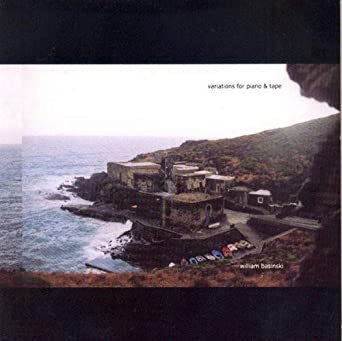
William Basinski
Variations for Piano and Tape
(2062; 2006)
By Craig Eley | 18 August 2007
Since the very beginning of sound recording technology, like 1878 or so, there has been a direct correlation between the ability to record one’s voice and the ability to transcend death. Sound theorist Jonathan Sterne in his brilliant book, The Audible Past, claims that the “defining figure” of sound recording “was the possibility of preserving the voice beyond the death of the speaker.” Recorded sound had the possibility to transcend death, yet at the same time the process of recording, which resulted in a product that was static, also froze that speaker “forever.” Communications scholar John D. Peters is worth quoting at length: “The phonograph disembodied and even immortalized sound; exerted a kind of erotic control at a distance; and was as promiscuous in its distribution as it was faithful in its invariant narrative.”
But of course, the narrative did not prove to be entirely “invariant.” Early sound recordings were very fragile, and, again calling on the work of Sterne, death was as much a part of recording as the hope for eternal life. In a very literal way, decay and deterioration make the earliest recordings that we have unlistenable. And, on another level, ideas of the seeing and hearing the departed in other mediums (radio, telephony, photography) were quite popular when these technologies were new. Sound recording, even in our era, maintains a type of fragility: the tape eaten by the machine, the compact disc snapped in half, the scratched record, the erased hard drive.
Of course, no living composer comes to mind who bases their work on the lines between death and immortality, music and technology, time and space, growth and decay, more than William Basinski. Basinski’s loops, most shatteringly exemplified through The Disintegration Loops, dance along and between these faults, reminding us, always, of the ephemeral nature of life itself. In Variations for Piano and Tape, while not quite as dramatic a concept as the Loops, a tape loop falls off of the head, thus resulting in subtle yet dramatic stops and starts in the piece, and counterpoints and distorted sounds that literally appear (and subsequently disappear) out of nowhere.
Basinski has been called, at least by the Village Voice, the American Eno, and the comparison is obvious, though perhaps a bit thin. Indeed, the sound of “Variation #9: Pantelleria,” which at 44 minutes is the single track on this disc, is immediately reminiscent in tone of “1/1” from Ambient 1: Music for Airports (1978), and in process from the extended tape loop delay system used on Discreet Music (1975). Those pieces, however, actually achieved a type of sonic “perfection,” and here it is the process of imperfection that becomes the defining force.
The irregularity and unpredictability of the loop is compelling, but somewhat hindered by a dull piano as its foundation. What I became most interested in, especially once the piece reaches the 20-minute mark and novelty of the technique has worn off, is the sounds of the machine itself. Drifting in an out in the same haphazard way as all of the elements here, I found myself seeking them out, waiting for them, wondering exactly what “they” were. With this type of process, of course, it is often difficult to tell what precisely you are hearing, but there are moments of creaking, or small gears turning, or something, that seemed to penetrate to the core of this work. Ultimately, this piece relies on technology, and it was the noise of that technology that compelled me to listen on.
The piano of this piece is consistent with Basinski’s other work, meaning it’s beautiful, slow, and ultimately a bit reminiscent of other people’s work, including, well, Eno’s. It’s also what holds the album back from a higher score. Even when the floundering tape is looping and stuttering in interesting ways, I wish that something more could happen with those five notes. (Five notes for forty-plus minutes.) Basinki’s work, however, is conceptual as much as sonic, and his significance, at least for me, is not based on “innovation.” It is linked to and based on the past—a shared past where fears surrounding technology and death led people to speculate wildly about their futures, both in this life and after it. These questions are physical as well as spiritual, and Basinki’s insistence on irregularity, chaos, and decay also ask questions of both the present and the future, where the lines between bodies and technologies, organic and artificial, creation and destruction, will continue to blur.





